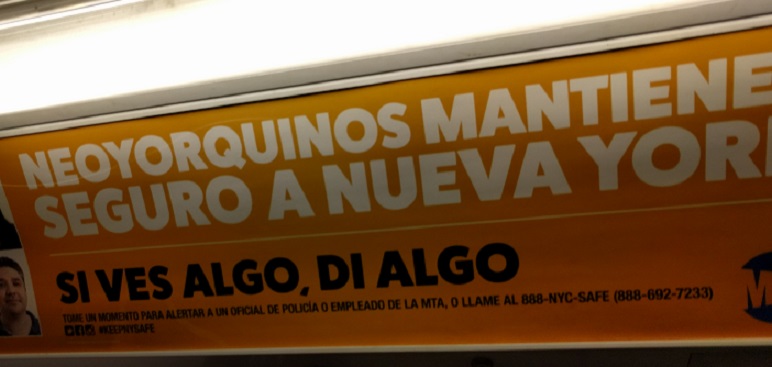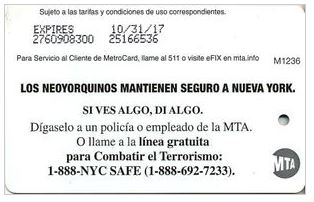Because Spanish has so many different ways to say ‘you’ — singular and plural, informal and formal — it’s important for Spanish speakers and writers to identify the appropriate version for each person or group they address, and stick with it. I always “ding” my students if they, for example, waver between formal usage (usted) and informal (tú) within a paragraph.
A public service poster currently on display in New York City subways features an error along these lines.

This is a mediocre phone snapshot, I’m afraid, but I hope you can make out, after the large black words Si ves algo, di algo ‘If you see something, say something’, the smaller black words Tome un momento para alertar a un oficial de policía o empleado de la MTA, o llame al 888-NYC-SAFE ‘Take a moment to alert a police officer or MTA employee, or call 888-NYC-SAFE’.
I have put the key verbs in red. The grammatical problem here is that ves ‘see’ and di ‘say’ are tú commands, but tome ‘take’ and llame ‘call’ are usted commands. Obviously, the MTA would do better to choose one mode of address and stick to it. Specifically, they should change tome and llame to toma and llama to reflect the informal usage of the ubiquitous Si ves ago, di algo slogan.
New York is full of educated Spanish speakers. Surely some of them work for, or consult with, the Metropolitan Authority (MTA)? As someone who profoundly cares about the Spanish language, I find this kind of bureaucratic carelessness infuriating and even insulting.
While searching for a better image of this poster, I came across a blog post about Si ves algo, di algo by a professional interpreter. He complained that this slogan itself is Bad Spanish. He argues that an English speaker hearing or reading If you see something, say something naturally interprets say something as say something about it, whereas a Spanish speaker does not make the same inference.
My native English intuitions in this case have been blurred by years of exposure to the slogan, and I am not a native Spanish speaker. Therefore it is hard for me to judge whether this interpreter’s nuanced distinction is correct. Readers, help me out here!
Next day: The same sequence of Spanish (more or less) is reproduced on the back of Metro Cards (subway passes), so you can see the writing clearer. Here what bothers me is all the Bad Spanish capitalization (e.g. “Combatir el Terrorismo”).

Hi:
I think is Ok, the principal message with the informal and direct “tuteo” and the most formal paragraph using the formal “usted”. In Spain in used in commercials about medicines, or in the official advertisements about traffic. What I do not like is that “tome un momento” it sounds Spanglish to me. “Tomar un momento” means “stop and think carefully” not just “spend some time” And i’d write “alertar a un oficial de policía o A UN empleado de …”
Un saludo
¡Qué interesante! So…perhaps not Bad Spanish after all! It’s interesting, though, that here you are objecting not to the tú/usted variation that bothered me, nor to the di algo that bothered the other blogger, but to two other linguistic issues: Tomar un momento) and the need to repeat a un. Poor MTA — so much to get right, so many ways to go wrong!
And what about ‘mantener’ in indicative? Why not ‘mantengan’?
My phone cut off the final -n of ‘mantienen’. This is part of yet another slogan, “Los Neoyorquinos Mantienen Seguro a Nueva York”, i.e. ‘New Yorkers keep New York safe’.
I agree with the translator. I think a better Spanish translation would be something like “Si ves algo, dilo”.
Another problem I find with that sign is the adjective “seguro”. I’m surprised nobody has mentioned it. To me at least Nueva York is feminine, so the adjective should be “segura”.
1) I agree that it should be “segura” (the full name is “Ciudad de Nueva York”). Also, it should be “Los neoyorquinos,” not “Neoyorquinos” – i.e., the message is that ALL New Yorkers are keeping the city safe. “Neoyorquinos” would suggest that only some New Yorkers are responsible for our safety.
2) I agree with Fernando that, while a bit awkward, Spanish advertising can use “tuteo” and then move to formal Spanish in the “small print” or boilerplate.
3) I’m sure it would be more correct to say “Si ves algo, dilo” – this is a hard decision for a translator who doesn’t know that in “If you see something, say SOMETHING,” the second “something” actually means “it.”
4) The person who wrote the card definitely got it better, even with the capitalization error – at least they made sure to get rid of the heinous “Tome un momento.”
‘Tome un momento’ is Spanglish, and most Spanish-speaking New Yorkers speak Spanglish. So I think it’s fine, even if it doesn’t fit with continental Spanish rules. It is perhaps more natural to a New Yorker than it is to you.
Worse and worse! I agree about the gender problem — a good point.
Pingback: Bad Spanish?? — high culture edition | Spanish Linguist
A grammar stickler would also object to the masculine form ‘seguro’ alongside ‘Nueva York,’ which is clearly feminine!
¡Es verdad! Some other commenters noticed the same thing.